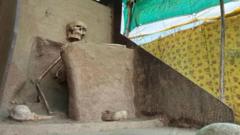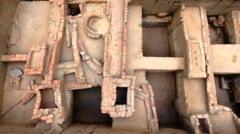The long-awaited transition of a 1,000-year-old skeleton into a museum setting took place recently in Vadnagar, Gujarat, as authorities sought to rectify years of oversight following its discovery. The ancient remains, which were found in a sitting cross-legged position, had been left unprotected in a makeshift tarpaulin shelter for the past six years due to bureaucratic disputes.
On Thursday, the skeleton was meticulously transported to the Archaeological Experiential Museum in Vadnagar, situated just a few miles from its excavation site. The careful relocation involved guidance from experts to ensure its preservation, with plans to display it publicly once the necessary administrative steps are finalized.
Mahendra Surela, curator of the museum, assured that the skeleton would be examined by the Archaeological Survey of India (ASI) to determine the best display method. Currently, the skeleton is secured near the museum entrance, surrounded by a protective barrier, and discussions are underway regarding its potential relocation to a second-floor exhibit alongside a photograph of the find.
The skeleton's discovery in 2017 was made by archaeologist Abhijit Ambekar, who emphasized the high significance of this rare find, with only three comparable skeletons found in India. Initially, due to disputes over custodianship, the skeleton remained exposed to environmental damage despite its historical importance.
Experts have suggested that the skeleton likely belongs to the Solanki dynasty, which ruled parts of Gujarat from the 10th to the 13th centuries, with the surrounding soil aiding in its remarkable preservation. Ambekar hopes this find can provide further understanding of "samadhi burials," an ancient Hindu practice where revered individuals are interred rather than cremated, underscoring the rich cultural heritage of the region.





















